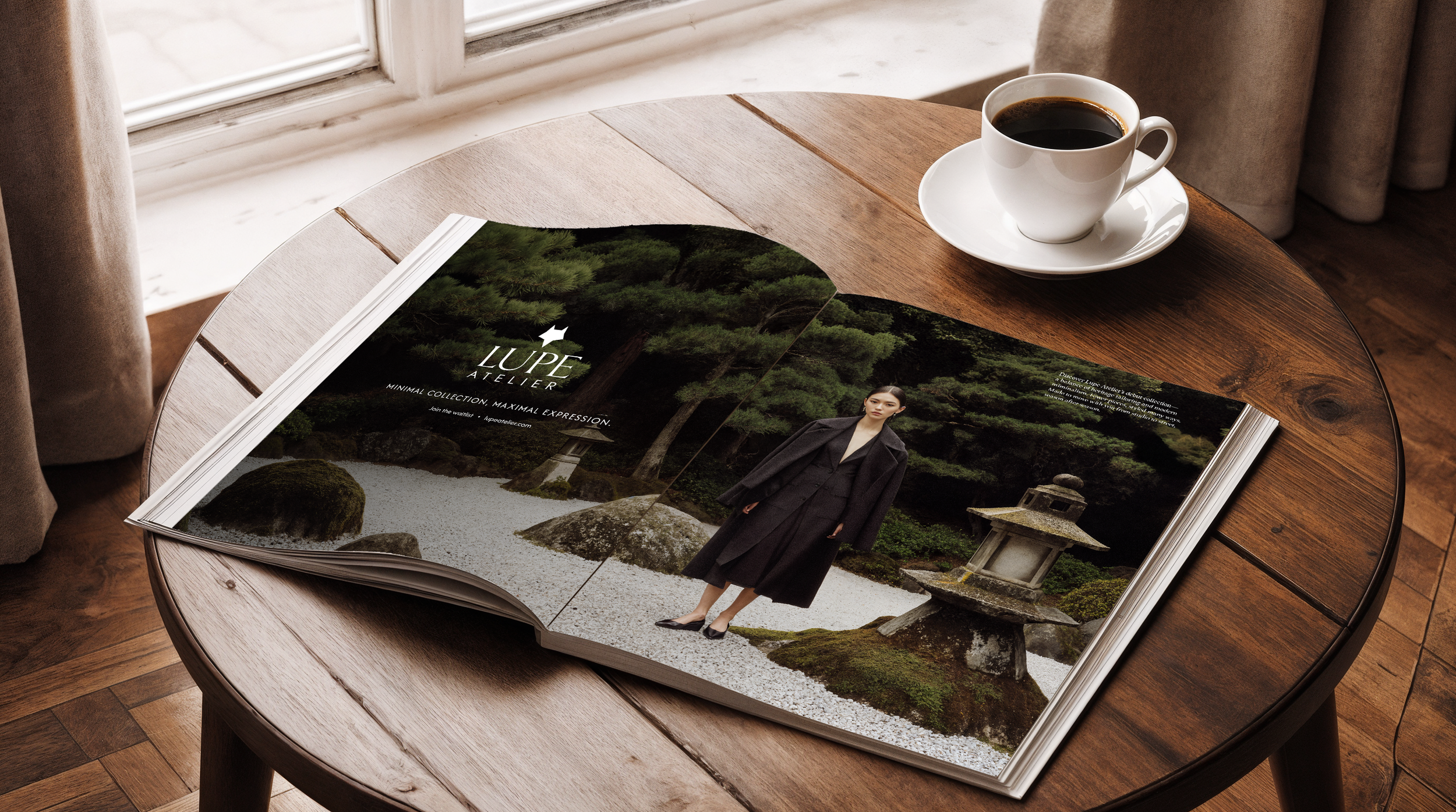Artificial Intelligence Campaign
Reflections and execution of AI in advertising
Leveraging a combination of KREA AI, ChatpGPT, and Adobe Photoshop, this is a magazine ad spread for the fictitious brand Lupe Atelier.
Reflection: The 6-Finger Problem
“It was impossible to expect a moral awakening from humankind itself, just like it was impossible to expect humans to lift off the earth by pulling up on their own hair. To achieve moral awakening required a force outside the human race.”
– Liu Cixin, The Three-Body Problem
Hands are one of the most challenging parts of the human body to draw. The same is true in generative artificial intelligence (AI). No matter how realistic a model’s face or garment may appear, hands often reveal the machine’s weakness—sometimes sprouting six fingers or ten toes. The “six-finger problem” is more than a quirk; it’s a reminder that AI is not foolproof. It requires the human touch: scrutiny, refinement, and aesthetic judgment. As with art itself, we must interrogate whether AI outputs—whether a line of copy or a generated photograph—actually align with truth, strategy, and meaning.
AI is often marketed as a one-stop solution for cost-cutting and efficiency. But in the creative fields, it is not so simple. With roots in the 1960s and 1970s, AI has grown into an external force now reshaping how we communicate, interact, and create. For artists and designers, this force is both exhilarating and unsettling. It quickens iteration, but also raises questions of value and authenticity.
For this assignment, I built a fictitious campaign for Lupe Atelier, a minimalist fashion brand that aspires to create sustainable, biodegradable clothing that endures beyond the churn of fast fashion. The campaign was not produced on a single platform. Instead, I wove together three tools—Krea AI, Photoshop’s generative AI, and ChatGPT—each playing a role in photography, video, editing, and copywriting. Lupe is derived from Guadalupe, meaning “river of the wolf,” while atelier is the French term for a studio or workshop. Together, the name grounds the brand in both archetypal symbolism and fashion tradition.
The creative direction leaned into the Japanese aesthetic of wabi-sabi: wabi signifying simplicity and humility, sabi the beauty of impermanence and age. Wolf imagery underscored themes of loyalty, spiritual power, and protection. In the visuals, this came through as clean architectural lines softened by natural fabrics and folds. The brand narrative was clear: these clothes are not about spectacle or dominance. They are about presence, grace, and the quiet confidence of wearing something enduring.
One of the most interesting tensions in this campaign was the juxtaposition between human-crafted clothing and machine-crafted art. In fashion, the shift to synthetic textiles enabled massive profits for brands selling polyester dresses for hundreds of dollars, while truly biodegradable fabrics remain costly and niche. The same analogy applies to AI art: the more synthetic content floods the market, the more value we may eventually place on work that bears the unmistakable hand of the human. A question lingered as I worked: as “synthetic” AI becomes more common, will purely human art, design, and writing grow more precious?
The tools each had their role. ChatGPT became a partner in writing prompts and shaping copy. Krea AI generated fashion images, applied visual styles for consistency, and used upscaling features to translate low-resolution ideas into high-resolution assets. Photoshop AI refined the details, enabling compositing and correction. This workflow allowed me to produce a campaign that looked cohesive across logo, print, OOH, social, and video deliverables.
Instagram social carousel.
Yet the process was not without challenges. AI often rendered clothing folds beautifully but distorted hands, jewelry, or background elements. Consistency across multiple outputs required testing, re-prompting, and human judgment. I did not spend significant time watching tutorials because, after working with AI for several years, the tools feel almost second nature. But this in itself raised a new awareness: the more intuitive AI becomes, the easier it is to lean on it. Overreliance on machine learning risks eroding the very soft skills that define human creativity—judgment, empathy, narrative sense, and moral responsibility.
For me, AI is a tool in the toolbox. It enables rapid iteration, idea testing, and concept building. On an advertising team, I would apply it to speed up moodboards, concept visuals, and exploratory copy, while reserving human craft for refinement and strategy. What AI cannot provide—and must never replace—is moral reasoning and emotional depth. To hand those over to a machine would be sacrilege to the
human experience.
Ultimately, AI is both breathtaking and terrifying. It can help us imagine new worlds, but it cannot tell us why those worlds matter. As creators, our responsibility is to walk alongside it with optimistic caution, ensuring that our humanity remains at the core. The six-finger problem is not simply a glitch; it is a reminder that the human element—our eye, our touch, our judgment—remains indispensable.





